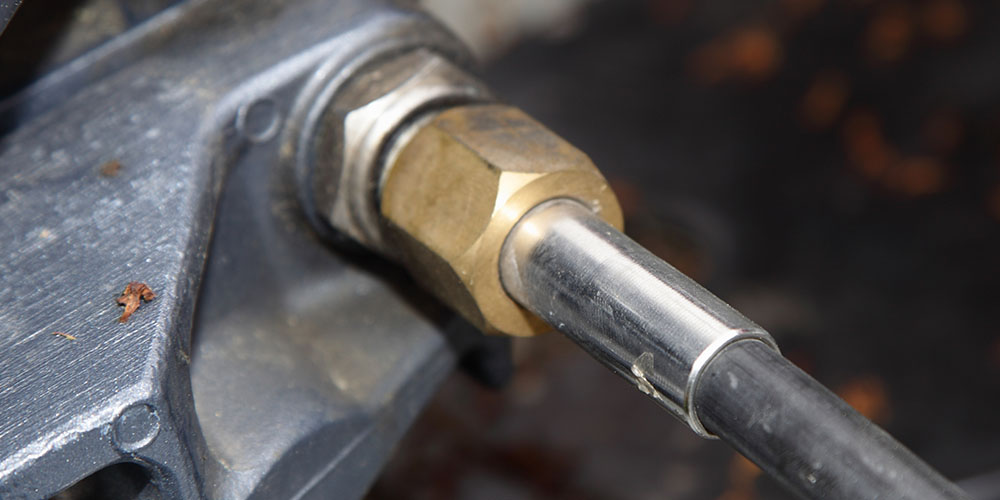
Boaters generally pay little attention to their boat’s steering system, as long as it does the job without excess friction or play, but as our boats age, the steering system may need replacement.
When installing new steering, it’s good practice to replace a steering system with one of the same type as was originally installed in your boat—rotary with rotary, rack with rack, hydraulic with hydraulic. This ensures that your boat will continue to handle as it was designed, and simplifies the installation process (a very doable DIY project for many boat owners). Try to identify the type of cable from marking on the jacket, and the helm from lettering on its cast/molded body.
Repair parts for mechanical steering helms, cables and engine connection kits are not available. These components must be replaced as units for safety and convenience and, since engine interfacing is standardized (on systems newer than 1976) your task is simple. If you want to improve performance for faster response or lower steering effort, upgrading to No Feedback, power-assisted mechanical or hydraulic steering can result in a big improvement. The retrofit becomes a lot more complicated, however, requiring careful consideration of fit, performance and value. Changing from the original steering configuration may affect your boat’s handling and feel, and may be made a bigger challenge due to modifications required to accommodate the new components. Be sure to water-test your new system carefully as you become familiar with the changes in your boat’s maneuvering.
Parts of a Mechanical System
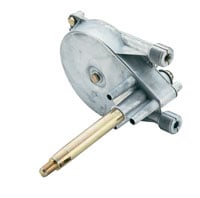
Safe-T rotary helm has a relatively quick three turns lock-to-lock, but has a bulky gear housing, so is almost 7" wide.
Mechanical Steering Systems achieve good handling performance and provide safe operation for smaller powerboats (up to 34'). They consist of a wheel, helm, push-pull cables and connection kits—hardware that allows you to connect your steering system to your boat’s I/O or outboard engine. We’ll start by looking at the most important component, the helm.
Rotary Helms
The helm is the mechanism behind the instrument panel that converts the wheel’s rotary motion into a push-pull motion on the cable. The steering wheel attaches to the helm. Rotary steering helms have a round gear around which the cable turns as you turn the wheel. There are two types of rotary helms, with different applications, strengths and weaknesses.
Reduction gear type: One or more gears mesh with the steering drum to move the helical core of the steering cable. This original rotary design (which include the Big-T and Safe-T helms) is still best in terms of strength and efficiency, since there are usually only two gears. These helms have the drawback of requiring a fairly large round assembly behind the dash, since the steering shaft is located outside the cable drum, so they often cannot be installed in smaller, more crowded dashboards.
Planetary gear type: This alternative style uses three or more gears that mesh internally with the cable drum to move the core of the steering cable. The Safe-T II design from SeaStar, or the similar Rotech T71FC helm from Uflex, takes up the least possible space behind the dash, so it’s recommended for boats with small dashboards, or with instruments clustered around the wheel. Drawbacks include many wear points and more accumulated backlash (free play or “slop”) from four or more gears meshing (compared with two typically found in reduction gear helms). They fit outboards up to V-4 size only.
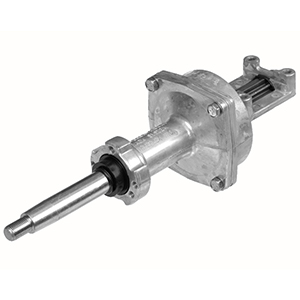
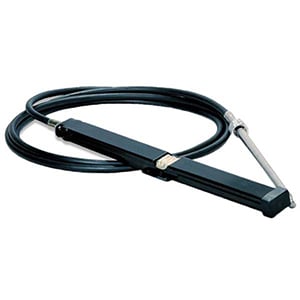
You can buy replacement rack helms and cables separately, or save money by ordering a mechanical steering kit from either Uflex or Seastar Solutions
Rack and Pinion Helms
The rack and pinion helm includes a pinion gear fitted directly on the steering shaft that engages a rack gear in a tubular housing. Rack steering is the most efficient mechanical system for moving the cable, but its drawback is its width. Rack steering requires a long rack housing that cannot fit behind many dashboards. Although a rack and pinion helm can be installed at several different angles in relation to the dash surface, using 10° or 20° wedge kits mounted under the bezel (the mounting bracket and trim ring), rack helms have less mounting flexibility than rotary helms.
The primary difference between a rack and pinion and rotary helm is the form factor of the helm—how it fits in the space behind the mounting surface. Rotary helms extend a few inches above and below the axis of the steering wheel, and a few inches in the opposite direction of the steering cable. On boats with very low dashboards, rotary helms may not have enough vertical clearance. Rack and pinion helms are long rectangular boxes extending about 1' away from the direction of the cable, but they are very compact vertically.
Mechanical Advantage—Response vs. Effort
Another attribute to consider is the mechanical advantage of the helm, or how “fast” it turns. When a helm is specified as having a certain number of turns “lock to lock,” it means the number of steering wheel rotations necessary to fully extend the cable from a retracted state. Faster gear ratios (3:1) require fewer turns, but there is heavier helm pressure to offset engine torque. Slower gear ratios (4.2:1) require more turns, but there is less helm pressure when turning against prop torque.
No FeedBack or Zero Torque Technology
Most steering systems in our catalog are available as standard or No FeedBack (NFB) types. No FeedBack, which Uflex calls “Zero Torque”, isolates the driver from the engine’s torque. With traditional steering systems, the engine has a tendency to turn to the right, which the driver compensates for by keeping pressure to the left on the wheel. This also allows the boat to turn rapidly to the right should the driver lose his/her grip on the wheel, resulting in a dangerously tight turn.
NFB helms have a clutch mechanism built in which keeps the boat on course without constant fighting. The only time you feel the engine’s torque is when you turn the helm. There are no disadvantages to the NFB systems, other than a modest $40.00 additional cost over regular systems, and we heartily recommend them if you are replacing your steering system. NFB cannot be used with PowerAssist or autopilots.
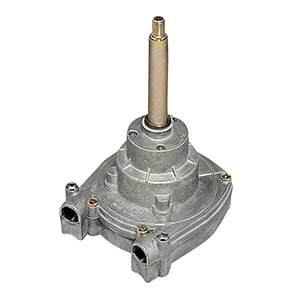
Big outboards have lots of torque coming from the prop. The UFLEX Zero Torque helm locks this out, isolating you from this constant tug on the wheel.
Steering Cables
Dual (Twin) Cable Systems
Mechanical steering systems rely on push-pull steering cables to move your engine or rudder, but all cables include some backlash or lost motion, due to the nature of their design. Some high-performance boat/engine combinations (with maximum speeds above 50mph) cannot tolerate this amount of play, and develop high-speed instability. We recommend dual cable mechanical systems (or SeaStar PRO hydraulics) for these performance boats. Dual cable steering allows you to remove most of the backlash by adjusting one or both cables at the engine, minimizing engine flutter and handling instability.
Maintaining your steering cable
We suggest the following periodic maintenance (at least twice a season). Clean and lubricate the engine tilt tube or cable support tube, and the steering cable telescopic output ram as follows:
- Remove the steering cable from the tilt tube
- Clean the tilt tube inside diameter thoroughly
- Remove corrosion in the tilt tube with a wire brush. Wipe until all loose material is removed.
- Lubricate the tilt tube with a good water-resistant grease
- Scour the steering cable telescopic ram with a brass wire brush and wipe until clean
- Lubricate the sliding parts of the telescopic ram with a high-quality water, resistant grease
- Reassemble making sure all fasteners are correct and tight and there is no binding or excessive free play in moving parts
Pro Tricks for Installing a Steering System
Be sure you have the correct cable for the helm on your boat. There are several kinds of cables and helms that are not interchangeable. This applies whether the system is rotary or rack and pinion.
Mechanical helm replacement: The mounting hardware for NFB 4.2, Safe-T II and HPS helms fits the Safe-T dash cutout. NFB Rack helms fit 1984-date "The Rack" mounting holes. 1996-date back mount rack helms use a wider rack cable and will not work with old style rack cable (SSC124XX).
Outboards (without power steering): No feedback/Zero Torque (mechanical steering), BayStar or SeaStar (hydraulic) are recommended as replacement steering for all non-power-assisted outboards. For high performance boats or other applications in which there may be engine flutter or some steering instability, dual cable NFB (4.2/Pro Rack) mechanical systems or SeaStar PRO hydraulic systems are recommended. For most rotary steered boats made after 1993, upgrading to NFB can be as simple as a helm and bezel change.
Sterndrives and outboards (with power steering): HPS™ High Performance Steering is recommended for power-steered sterndrives and other power-assisted applications. Traditional mechanical systems (Safe-T QC and Back Mount Rack & Pinion) may also be used for power-assisted applications. A BayStar or SeaStar hydraulic system is recommended for all vessels using autopilots.
Replacing the mechanical system with a hydraulic system: SeaStar helms retrofit into most boats. The SeaStar front mount cylinder is best for outboards with 22" splashwells or wider. Side/splashwell mount cylinders are available, but require more room. Check splashwell dimensions before ordering outboard cylinders.
Allow for generous (large) cable bends, notably where the cable exits from the helm (or rack housing) and where the cable makes the bend to connect with the engine, drive or rudder. The tighter the bends, the stiffer the cable will be in operation. Also, tight bends reduce the lifespan of the cable. An 8" bend radius is generally the minimum bend radius recommended for SeaStar cables.
If you’re using zip ties to secure the cable along the gunwale area, allow a little slack (don’t cinch them completely tight). A little slack in the attachments allow for the cable to flex as it’s actuated, for smoother operation and longer cable life.
When installing the cable at the engine end, be sure to lubricate the telescopic ram (the part that slides in and out) with plenty of good waterproof lithium-based grease. This is especially important if the steering cable is connected through the engine tilt tube, as this area tends to get very rusty. Advice from the professionals at SeaStar is “always remember: grease, grease, grease.”
How to Measure for Mechanical Steering Cables
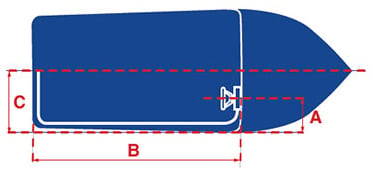
Refer to the diagram at right. Start by adding dimensions A + B + C.
For installations through engine tilt tube.
A + B + C + 6" = cable length (round up to the next largest size)
Example: A = 18" B = 96" C = 24"
Total: 138" + 6" = 144" = 12 ft. cable
For installations mounted to transom or splashwell.
A + B + C - 6" = cable length. (round up to the next largest size)
Example: A = 18" B = 96" C = 24"
Total: 138" - 6" = 132" = 11 ft. cable
For more details on how to measure for mechanical steering cables see the Teleflex-Seastar PDF.
View our current selection of Mechanical Steering Products.